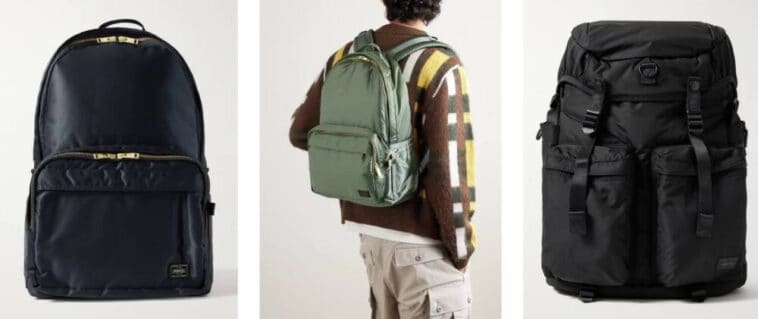As I strolled through the streets of Tokyo, armed with an appetite for all things fashion, a peculiar trend caught my eye – the Japanese backpacks! You might be wondering, “What’s so special about these bags?” Well, let me tell you, my friend, they’re on a whole other level.
To my surprise, these backpacks carried quite a hefty price tag. As someone who loves a good backpack, I couldn’t help but wonder, “Why are they so expensive?” You may think that high-class designer brands would be the culprit, but these costly bags can be found in everyday settings, from preschools to office buildings. There’s more to this story than just flashy aesthetics and brand names.
Page Contents
Why We’re Laughing about High-End Backpacks
Oh, those fancy Japanese backpacks! They’re high-quality, stylish, and most importantly, they bring joy to my wallet by lightening it considerably. Who wouldn’t want to spend all their hard-earned cash on a luxurious bag to carry things, right?
Well, I’ve got to hand it to our friends from the Land of the Rising Sun – they sure know a thing or two about craftsmanship. It’s not every day you find bags made with such excellent materials, tailored stitches, and utmost attention to detail. I mean, when it starts raining, I’ll be glad my precious backpack is equipped with that premium waterproof coating. It’s the little details that count, after all.

So, what’s the secret sauce behind these pricey bags? Well, let’s start with their Euro-cool Japanese aesthetic. The sleek designs, coupled with hints of tradition, always manage to catch my eye. It’s like they’re whispering in my ear, “You know you want me; I’m the perfect blend of East and West.” Pure temptation, I tell you.
But wait, there’s more! High-end backpacks from Japan are known for their superior materials. You might find bags made with grade-A ballistic nylon (I wonder if James Bond has a Japanese backpack?), flawless zippers, and other ultra-durable components. Frankly, if my backpack doesn’t shield me from a hailstorm of bullets and ninja stars, I’d be disappointed.
Now, let’s not forget about those amazing organizational compartments. It’s as if these bags were designed by Marie Kondo herself! With just the right pocket for every item, I can finally keep my life in order (well, as much as possible). My headphones won’t get tangled with my pens, my snacks won’t end up flattened, and my keys won’t elude me – peace of mind in bag form.
Ultimately, humor aside, I really have to appreciate the time and effort that goes into crafting these luxurious Japanese backpacks. Yes, they’re expensive, but they reflect an exceptional level of quality and thoughtfulness. So while we might chuckle at the price tags, maybe all those amazing features are worth it after all.
Material Matters: Unraveling the Price Tag Mystery
Ah, the age-old question of why Japanese backpacks have price tags that make our wallets cry. Well, my friends, it’s all about the materials. Let me take you on a journey through the world of backpack fabrics that hold the secrets to these high prices.
First, many Japanese backpacks use a material called Cordura. This stuff is tough, I mean really tough. In fact, Cordura is so strong that it’s often used in military gear and motorcycle jackets. Why, you ask? That’s because it’s resistant to abrasions, tears, and just about everything else the schoolyard can throw at it. So, yes, while it may be a pricey material, you’re definitely getting bang for your buck in terms of durability.
Now, let’s talk zippers. Quality zippers are essential for keeping our precious belongings safe inside our bags, and Japanese backpack manufacturers don’t skimp on this aspect either. Most Japanese backpacks use zippers from the reputable YKK company. These little wonders glide smoothly, don’t get stuck (usually), and most importantly, hold up to lots of use. And guess what? YKK zippers ain’t cheap either.
So, we have an expensive, yet highly durable fabric and top-notch zippers. But wait, there’s more! A lot of Japanese backpacks are also made with reinforced stitching, ensuring that seams don’t suddenly burst open at the most inopportune moments. And while we’re at it, let’s throw in some ergonomic straps designed to distribute weight evenly and make those heavy textbooks less of a burden on our shoulders. With all these high-quality materials and construction techniques, it’s no wonder that the price tag seems to climb higher and higher.
There you have it, my curious friends. The secret behind expensive Japanese backpacks lies in the superior materials and craftsmanship. And while they may cost a pretty penny, I’d say it’s a small price to pay for a backpack that stands up to the tests of time, heavy loads, and even the rough and tumble schoolyard.
Craftsmanship: The Art of Making Expensive Backpacks
I was strolling down the streets of Tokyo when I first noticed the high-end backpacks on the backs of fashionable locals. It got me thinking, what makes these Japanese backpacks so expensive? Turns out, it’s all about craftsmanship!
Check out this youtuber review of Porter Bag
To start with, let me tell you about the meticulous attention to detail in their design. Each backpack is carefully stitched, with every seam being tested for durability. You can almost hear the backpacks whisper,”I dare you to find a loose string!” No wonder they last for years, if not decades.
Let’s talk about the materials used in the making of these exclusive backpacks. I’ve come to know that the Japanese are picky about quality. They prefer using high-grade materials like leather, ballistic nylon, and Cordura, which are known for their sturdiness. These choices bump up the price, but hey, I wouldn’t mind spending a few extra bucks for a backpack that refuses to wear and tear!
The thing that I find most amusing is that craftmanship extends beyond just the backpacks themselves; even the zippers and buckles are of premium quality. I could play with these top-notch zippers all day long, sliding them back and forth with ease. The buckles? They click just right, making snapping them together oddly satisfying.
One fact that’s blown my mind: these backpacks have such a sense of humor that they make a bold fashion statement by juggling practicality and style. They have compartments designed for any occasion – whether you’re going camping, or to a board meeting – all the while exuding an aura of sophistication. It’s as if they’re saying, “Look at me being practical AND stylish. Try to keep up, will you?”
So, the next time you see a pricey Japanese backpack, remember the craftsmanship that goes into producing these sleek and durable bags. The love, care, and attention to detail ensure that Japanese backpacks live up to their reputation and remain a sought-after accessory. It’s not just a backpack, it’s a piece of art with a dash of humor on the side.
The Brand Name Games
Ah, the mysterious world of Japanese backpacks, where prices seem to be more inflated than a pufferfish at a sushi bar. Let me tell you why the brand name plays a huge role in this phenomenon.
First of all, you’ve got your high-end designer labels like Herschel and Master-Piece. These backpacks don’t come cheap – the velvety soft leather, intricate detailing, and embossed logos all contribute to the hefty price tag. But hey, what’s a little extra cash if you can make your fellow commuters green with envy?
Then, we have the oh-so-iconic Randoseru backpacks that are popular among Japanese school children. They may seem like regular backpacks, but the craftsmanship behind them can make your jaw drop.
Made from high-quality materials (think genuine leather), these backpacks are designed to last through years of rough and tumble, a test of endurance even for the Energizer Bunny. To top it off, the brands that produce these bags often have decades of history, adding prestige and a sense of tradition to the mix. Oh, the pressure of keeping up with the family backstory!
And let’s not forget the rucksacks straight from the land of the rising sun, which seem to possess mystical powers of wabi-sabi. Brands like F/CE and hobo have taken the art of backpack creation to a new level.
Combining functionality with minimalist aesthetics, these bags are designed to carry your belongings and elevate your street cred! But alas, the price of sophistication doesn’t come cheap. It’s as if the Yen gods themselves started laughing and throwing bills in the air just to spite us, mere mortals.
In summary, the luxurious materials, impressive craftsmanship, and unbeatable street cred of Japanese backpack brands all come with a hefty price tag. But for those willing to delve into the mystical world of high-end backpacks, great fashion shall be bestowed upon thee!
The Role of Import Taxes and Duties
Fly Me to the Moon: Space-Travel-Level Taxes
You might think the cost of sending a backpack to the moon would explain the high price of Japanese backpacks, but alas, it’s not that glamorous. It’s actually down to import taxes and duties. You see, these fancy backpacks are subject to import taxes imposed by various countries. I wouldn’t be shocked if someday we learn that the moon has started charging import taxes, too!
Import taxes vary depending on the destination, and in some cases, they can add a significant amount to the final price of that coveted backpack. So, keep that in mind when window shopping for a shiny new backpack from Japan!
Customs Got Your Wallet
If import taxes are like an out-of-this-world moon trip, then customs duties are a wallet-snatching Earth experience. When a backpack crosses international borders, it’s subject to customs duties. These duties are like that uninvited friend who shows up when you’ve planned a cozy night just for yourself.
Customs duties are often determined by factors such as:
- Material: Leather backpack? Congratulations! You may have to pay more in duties. Who knew your fashion sense could be so costly?
- Value: More expensive backpacks attract higher duties. You try telling customs that the backpack isn’t designer; it’s just infused with samurai spirit.
- Country of origin: Each country has its own unique relationship with Japan. Sometimes, that translates to higher duties on imports. Luckily, my relationship with sushi remains unaffected and duty-free.
So there you have it! Import taxes and duties can make your dream Japanese backpack quite an expensive investment. Now, if you’ll excuse me, I need to start planning my moon trip – perhaps customs will be kinder up there.
Fashion Statement: The Allure of Japanese Backpacks
I recall the first time I laid eyes on a Japanese backpack, and I thought, “Why on earth does that tiny bag cost a fortune?” Little did I know, Japanese backpacks are more than just ordinary means of carrying belongings – they’re fashion statements!
One can’t help but be wooed by the elegance and craftsmanship of these backpacks. The precise stitching, the delightful balance of function and style, and the subtle yet significant branding all contribute to their allure. As you walk down the streets of Tokyo, it’s nearly impossible not to spot someone donning the latest Japanese backpack trend.
Another aspect that attracts people to these backpacks is how they manage to stay appropriate for various environments. Be it a university campus or a business meeting, their versatility knows no bounds. I’ve personally experienced turning heads when I stroll into a room wearing my prized Japanese backpack, and it’s a feeling of pride I cherish.
One thing that cannot go unnoticed is the durability of these backpacks. They are designed to withstand the test of time, which partially justifies the steep price tag. I mean, if I’m going to splurge on a bag, I expect it to be around for the long haul! The materials used for these backpacks, such as ballistic nylon and Cordura, assure that they can endure daily abuse.
Finally, it must be acknowledged that there’s a certain degree of exclusivity associated with owning a Japanese backpack. For bag fashionistas like myself, it serves as a symbol of exquisite taste and appreciation for superior quality. In a world where knock-off designs and low-grade materials flood the market, investing in a genuine Japanese backpack is a testament to our devotion to authenticity.
So, while the price tag of Japanese backpacks might seem daunting at first, it’s essential to recognize the value they bring in terms of style, versatility, durability, and exclusivity.
Cultural Aspects Influencing Cost
Durable Debut: Longevity Tradition in Japan
As I wandered around Japan, I couldn’t help but notice their unique approach to backpacks. Trust me, I was taken aback when I first discovered the hefty price tags on these seemingly simple backpacks. But then, it hit me! You see, Japan is a country where people are all about incorporating longevity into their lifestyle. Their backpacks are no exception.
Allow me to explain – Japanese backpacks are made with high-quality, durable materials. As a result, they can last for years, even decades, making them a worthwhile investment. So, there’s no need to replace them every school year or so, like I’ve personally done with subpar bags. Had I known this earlier, I could’ve spared myself countless trips looking for replacement backpacks. Goodbye, remorseful retrospection!
Status Quo: The Influence of Social Status
Next up, let’s discuss the role of social status in the infamously high prices of Japanese backpacks. In Japan, purchasing an expensive backpack is a bit like buying a luxury handbag – it’s a symbol of your social standing. I can’t help but marvel at the role of these accessories in contributing to one’s sense of belonging and importance.
While it may sound preposterous, there’s something to be said about the feeling of belonging that comes with owning a symbol of status. Let’s be honest – we all know that sinking sensation when someone spots a hole in our backpack, and we awkwardly try to cover it up. Now, imagine radiating confidence, as the proud owner of a posh Japanese backpack. It’s a whole new world, my friends!
Check out these reviews we did earlier
So, dear reader, besides being meticulously crafted and designed to last, Japanese backpacks are oh-so-expensive due to their social significance. In a way, it’s a testament to the importance of both durability and status in Japanese culture. And who am I to deny the wisdom of centuries of craftsmanship and a need to fit in? So, I think I’ll stick to these not-so-ordinary backpacks. After all, I hate acting sheepish when my stuff spills onto the train platform.
Looking Beyond the Price: Are They Worth It?
I have to admit, when I first saw the price tags on Japanese backpacks, I let out a hearty chuckle and wondered if they were stitched together with unicorn hair. But after a closer look, I realized these backpacks offered more than just a pretty (and pricey) face.
First of all, I discovered that these bags are beasts when it comes to durability. They’re made with high-quality materials like Cordura fabric, which is known for being resistant to tears, scuffs, and abrasions. Plus, these bags are stitched with such precision that not even a curious squirrel could gnaw through the seams!
Secondly, I was impressed with the sheer amount of practicality. They include a plethora of well-designed pockets, compartments, and hidden nooks perfect for storing everything from my 27 pens (yes, I’m that person) to my emergency rice ball stash. Moreover, the bags are weather-resistant, which means I can confidently flaunt my Japanese backpack in a torrential downpour without worrying about soggy gadgets.
Lastly, their unique and stylish design cannot be overlooked. I mean, who wouldn’t want to rock a sleek backpack that effortlessly fuses function and form? With plenty of options to fit individual tastes, your Japanese bag could be the enviable centerpiece of your stylish ensemble – just don’t expect to blend in with the crowd!
So, are they worth it? For me, I’d say a resounding “yes!” These bags tick all the essential boxes –durability, practicality, and style– and even sprinkle in some bonus features. While they may require a pretty penny, I’ve come to appreciate the value in investing in my back’s bff (best friend forever).
Closing Remarks: Laughing All the Way to the Bank
As I wrap up my investigation into the high-priced world of Japanese backpacks, I can’t help but chuckle. The creators of these refined bags have truly found their golden goose, and customers are lining up to fill their coffers.
Now, I could dive deeper into the artisanal craftsmanship that goes into each of these backpacks, but let’s face it – if you’re looking for a punchline, there isn’t one. It’s really about value for money, and these backpacks have got it in droves.
- Durability: These bags have a reputation for being able to take a beating, which is just as well: I happen to be a master at overstuffing and mistreating my bags.
- Functionality: With all the compartments, sleeves, and clips that you could ever need, these backpacks have me prepared whether I’m diving headfirst into city life or taking a leisurely stroll in the countryside.
Of course, you could argue that there are other, less pricey options out there. But when you have the chance to own a little piece of functional art, I say go for it. Besides, there’s something to be said for making a statement with what you’re wearing. The instant you make the leap into the world of high-end Japanese backpacks, you’re not just saying “I appreciate craftsmanship,” you’re also saying, “Look at me, I’ve got style.” And let’s be honest, I’ve done far worse than this for the pursuit of style (shout-out to my neon-pink leg warmers).
At the end of the day, there’s a certain satisfaction in knowing that I’ve gotten my money’s worth out of my expensive Japanese backpack, and I’m sure many others would agree. With each new heavy load that threatens to split its seams, I chuckle warmly, knowing that my stylish backpack will pull through just fine – while, of course, laughing all the way to the bank.





